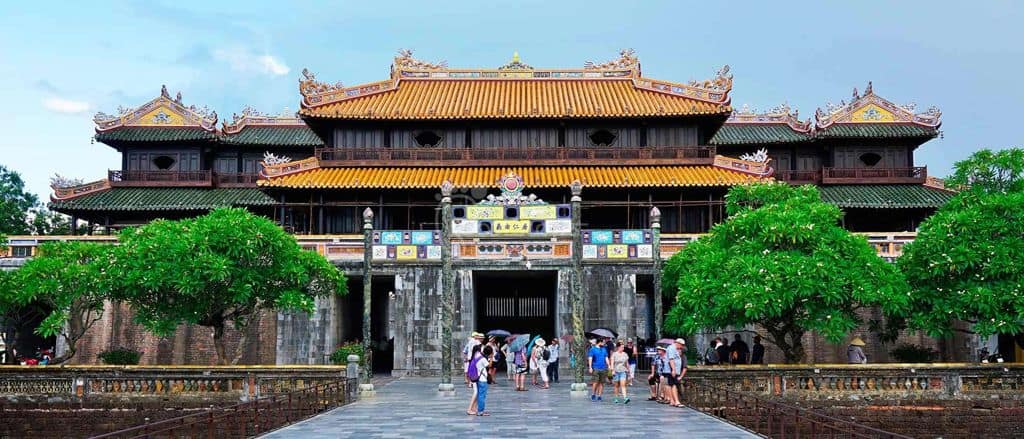Hue city is the must-go place for tourists who want to discover the middle section of Vietnam. Travelers visit Hue city mostly because of its famous tourist attractions and specialties. But, aside from those, do you know that some people also come to Hue because of its special weathers?
To further understand how the land’s location helps generate such a typical climate, let’s first navigate where this ancient city is on the Vietnam map, and eventually, you will know the best time to visit Hue.
Hue Location
Hue is located in Thua Thien-Hue Province, central of Vietnam. The old land borders Quang Tri Province in the north, Danang City in the south, and Quang Nam Province in the southwest. When people visit Hue, they’ll usually make time to visit Danang and Hoian as well because these two places are only 100km and 135km respectively away from Hue city.
Like most parts of Vietnam, especially the middle of Vietnam, Hue isn’t a landlocked city as it is situated much closer to the sea – the inland areas are only just some miles. Climates of Hue city is clearly controlled by the atmospheric circulation specifically created by the western Annamite (Truong Son) Ranges, which Hue leans against, on its west side and the East Sea on the other side. Though this particular situation is similar to Hoian and Danang, this doesn’t mean that the climate in Hue is strictly the same as those in the other two neighbor areas.
What’s the Weather Like in Hue?
The city of Hue is situated in the middle of Vietnam, and so obviously in the zone of tropical climate. Hue’s typical weather is hot and humid throughout the year, which is quite different from those in Vietnam’s Northern and the Southern regions because such climates are created by the passes (i.e., the Ngang Pass and the Hai Van pass) in the north and south of Hue city.
There’re two significant seasons in Hue:
- March – August: The dry season
- September – February: The rainy season
When you compare the respective temperatures of Hue and Hoian city, you’ll see that Hue’s average temperature is 2°C cooler than Hoian’s. However, in the summer months, there’re days that Hue can be much hotter. In fact, it’s known to be fiercer than most cities in Vietnam during the peak of the dry season. That’s because Hue’s special location is not only in the center of Vietnam, but it also sustains Laos’ hot southwest wind.
Further information about the important marks of Hue’s weather:
- February – March: The temperature is in perfect balance – neither very hot nor very cold. The sun is warmest during day times while the nights are pleasantly cool.
- May & August: This period of time is the hottest months of the year. During the day, the temperature can hit 40°C.
- September – February: The weather is cooler thanks to the rainfalls that may last for hours (or all day) and occur quite frequently. In December, particularly, the temperature may drop from 19.7°C – 8.8°C.
- October & November: They are the wettest months of the whole year.
So, What Is the Best Time to Visit Hue?
Most people say that the best time to visit Hue is in the dry season or during the transitional months. Usually, it is from January to April where the average temperature is about 20°C – 24°C; or from April to July where it is the nicest time to enjoy the beaches. That’s because during such times, the seascapes and landscapes in Hue city are at their best; even local travelers choose this time to visit Hue. Remember, dry months are the peak season. Consequently, accommodations are often limited and charged higher than usual.
On the other hand, there’d be fewer crowds as well as lower accommodation rates from September – December because most tourists would try to avoid the downpours, storms, and typhoons. However, there’re still many travelers planning to visit Hue during this season to enjoy and admire “Hue’s rains.”
To explain this, let’s not forget that Hue was once the capital of the Nguyen Dynasty. So, everything about it, was offered to it or for it, was special. Some remain so until this day. Even a natural phenomenon like the rains is one of Hue’s specialties.
This remark isn’t complete nonsense, though. Because, when you get to see it, you’ll see that Hue’s rains are indeed typical. While the rain is sprinkling and week-prolonging, the skies in Hue during this time are still painted with a mesmerizing blue hue. Even in such a daunting season, it only helps Hue appear to be more romantic, poetic, and somewhat nostalgic.


Recent Comments